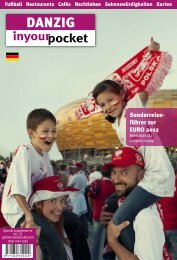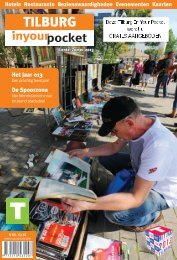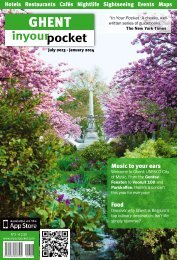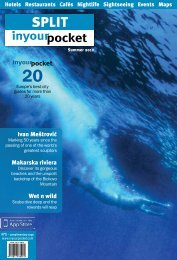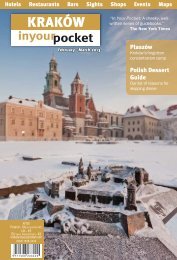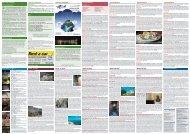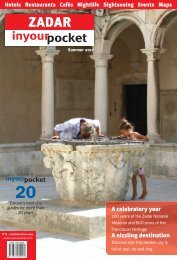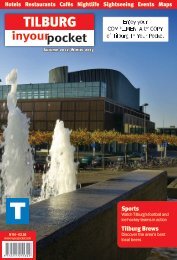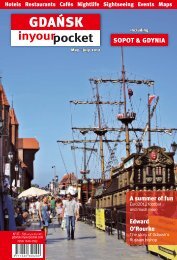Similar
Similar
Similar
Create successful ePaper yourself
Turn your PDF publications into a flip-book with our unique Google optimized e-Paper software.
28 MITTE MITTE 29<br />
Cold War Berlin<br />
The physical division of Berlin during 28 years, and<br />
the development of two completely separated cities<br />
on both sides of the Wall that ran between them, has<br />
led to huge differences that cannot be erased in a<br />
matter of a few years. Key sights relating to this era<br />
are the Gedenkstätte Berliner Mauer in Prenzlauer<br />
Berg, Checkpoint Charlie in Mitte with the Haus am<br />
Checkpoint Charlie Wall museum, BlackBox Cold<br />
War, Wall Panorama and Stasi exhibition, and the<br />
Tränenpalast, the former border crossing beside<br />
Friedrichstraße station. Get insights into daily GDR life at<br />
the DDR Museum in Mitte and the Museumswohnung<br />
WBS 70 out in the suburbs.<br />
sound installation adds to the experience. Q Open Sun, Mon<br />
10:00- 20:00, Tues-Thur 10:00-18:00, Fri 10:00-17:00; Mar<br />
& Oct until 14:00 on Fri; Nov-Feb also Sun-Thu until 18:00.<br />
Sat closed. Admission €3,50/3.<br />
Nikolaiviertel G-3, Nikolaikirchplatz, Mitte, MU<br />
Klosterstraße, www.stadtmuseum.de. Berlin‘s tiny<br />
medieval heart is the Nikolai Quarter, whose only truly medievallooking<br />
building today is the Nikolaikirche. The church dates<br />
to 1230 and was rebuilt along with the entire quarter in the<br />
1980s to mark Berlin‘s 750th birthday in the area in which the<br />
fishermen‘s settlement first began. No one was trying to outdo<br />
Walt Disney here, and many of the buildings have the simple,<br />
concrete facades that the GDR government could afford. The<br />
small shops in the area mostly deal in toys and souvenirs and<br />
tourists gladly fill the sunny tables at the restaurants that face<br />
the river. On Rathausstraße, there‘s a row of restaurants that<br />
flaunt old-fashioned Berlin cuisine and atmosphere. Other<br />
rebuilt historic buildings in the area date to the 1700s, such as<br />
the Ephraim-Palais and Knoblauchhaus. Both have changing<br />
exhibits related to Berlin.<br />
Potsdamer Platz E/F-4, MPotsdamer Platz. Once a<br />
busy intersection at the modern heart of a thriving metropolis,<br />
Potsdamer Platz was heavily damaged in the war, and suffered<br />
again when most remaining buildings were demolished<br />
to make way for the Wall‘s death strip. Hotel and office<br />
skyscrapers now add a cosmopolitan edge to the city, while<br />
to the east Leipziger Platz is almost rebuilt. The most popular<br />
public space and architectural attraction is the Sony Center,<br />
with its huge atrium and tent-like roof, best viewed at night<br />
for its impressive lighting. The neighbouring DaimlerChrysler<br />
complex holds architecture by Renzo Piano and Richard<br />
Rogers, and the Arkaden shopping mall.<br />
Reichstag F-3, Platz der Republik 1, Tiergarten, MU<br />
Bundestag, www.bundestag.de/htdocs_e/visits. The<br />
name together with its monumental size make most people<br />
associate Germany‘s neoclassical parliamentary building<br />
with the Nazis, but they have little history here. After hosting<br />
parliamentary sessions since 1894, it was set on fire just one<br />
month after Hitler was appointed chancellor in January 1933.<br />
It was a conference centre in the years during which it abutted<br />
the Wall, while later artist Christo famously wrapped it in cloth.<br />
It was used as parliament again after a reunited German<br />
government returned to Berlin in 1999. Renovated by Sir<br />
Norman Foster, this building is perhaps the most public federal<br />
building in the world through its glass dome. On the rooftop,<br />
photographs documenting the building‘s history circle the<br />
rim above the parliament chamber. Two ramps spiral up the<br />
side of the dome, an engineering feat even more fascinating<br />
than the panoramic view from the top. It’s best to book an<br />
entry time to the dome or for the 90-minute guided tour of the<br />
building in advance online; otherwise queue up for remaining<br />
places at the visitor centre just across the road. Photo ID is<br />
required.QOpen 08:00 - 23:00. Prebooked rooftop access<br />
every 15 minutes. Guided tours at 09:00, 10:30, 12:00,<br />
13:30, 15:30, 17:00, 18:30, 20:00. Admission free.<br />
Churches<br />
Berliner Dom G-3, Am Lustgarten, Mitte, MS<br />
Hackescher Markt, tel. +49 30 20 26 91 36, www.<br />
berlinerdom.de. The fourth incarnation of this Protestant<br />
church dating from 1905 might not look as massive if the<br />
Stadtschloss were still standing across Unter den Linden<br />
(the GDR regime demolished the castle in 1951). The royal<br />
Hohenzollern dynasty worshipped and was buried here. The<br />
climb up to the dome‘s rim is forgiving, with broad staircases,<br />
side exhibit rooms and good views. QOpen 09:00 - 20:00, Sun<br />
12:00 - 20:00. Oct-March open until 19:00. Admission €7/4.<br />
Deutscher Dom F-3, Gendarmenmarkt 1, Mitte, MU<br />
Stadtmitte, tel. +49 30 22 73 04 31, www.bundestag.<br />
de/kulturundgeschichte/ausstellungen/wege. The<br />
baroque ‚German Church‘ from 1701 was completed with an<br />
impressive domed tower in 1785; badly damaged by fire in<br />
the war it was only renovated in the 1980s. Owned by the<br />
state, the bare interior now houses an exhibition about the<br />
development of parliamentarian democracy in Germany - and<br />
how it came to fail so tragically in the last century. Be sure to<br />
see the views from the windows and the impressive building<br />
models on the top floor. Free tours in English are possible<br />
throughout the day; no booking is required for individual<br />
visitors. QOpen 10:00 - 19:00. Closed Mon. Admission free.<br />
Französischer Dom F-3, Gendarmenmarkt 5, Mitte,<br />
MU Stadtmitte, tel. +49 30 20 64 99 22, www.<br />
franzoesischer-dom.de. The northernmost domed tower in<br />
the Gendermenmarkt‘s grand architectural triptych dates back<br />
to 1785, and similarly to its counterpart was badly damaged<br />
in the war. It now has regular concerts in the simple baroque<br />
Friedrichstadtkirche church to the rear. Enter from the other<br />
side for the Huguenot museum (in German and French only),<br />
dedicated to the thousands of French protestants who moved<br />
to Berlin in the 17th century. Yet another entrance leads to the<br />
viewing balcony at 40 metres above street level, with great<br />
views all around. Q Open 12:00-17:00, viewing balcony 10:00-<br />
19:00, closed Mon. Admission €2/1, viewing balcony €2.50/1.<br />
Third Reich Berlin<br />
Wilhelmstraße, the centre of government in Prussia,<br />
continued to be so under Nazi rule. Between Unter den<br />
Linden and today’s Niederkirchnerstraße, the only non-<br />
Reich structure in 1936 was the British Embassy, which<br />
still holds its ground today in a modern building. The<br />
sole remaining example of fascist architecture is the<br />
former Reichsluftfahrtministerium (Air Force Ministry)<br />
built in 1935 by Ernst Sagebiehl. The grey building that<br />
once struck fear into the heart of Londoners is now the<br />
Finance Ministry. Hitler’s New Reichs Chancellory<br />
stood on Voßstraße but was demolished after the war.<br />
Not to let the red marble of its obnoxiously long hallway<br />
go to waste, the Russians lined the nearby Mohrenstraße<br />
U-Bahn station with it. The center of Nazi terror was on<br />
Prinz-Albrecht-Straße, today’s Niederkirchnerstraße. The<br />
Topography of Terror exhibit explains the functions of<br />
the various offices – including the SS and Gestapo - that<br />
once occupied the site.<br />
Memorials<br />
Führerbunker F-3, In den Ministergärten, Mitte, MS/U<br />
Potsdamer Platz. No educational historic plaques mark the<br />
site where Hitler committed suicide on April 30, 1945. For the<br />
last month of his life, Hitler lived roughly eight meters below<br />
ground in an air-raid shelter topped by a four-metre-thick,<br />
reinforced concrete ceiling. The unremarkable spot can be<br />
reached by walking to the end of In den Ministergärten, off<br />
Ebertstraße. A parking area surrounded by a pre-fabricated<br />
apartment complex covers the location, which was entirely<br />
sealed off during the complex‘s construction in 1988-89. The<br />
bunker was once accessed through the Festsaal (ballroom)<br />
behind the Reichskanzler-Palais on Wilhelmstraße.<br />
Memorial to the Murdered Jews of Europe F-3,<br />
Cora-Berliner-Straße 1, Mitte, MS/U Brandenburger Tor,<br />
tel. +49 30 26 39 43 36, www.stiftung-denkmal.de. This<br />
bluntly named memorial avoids any vagueness surrounding the<br />
term Holocaust. Six million Jews are estimated to have been<br />
killed by the Nazis and this site serves as Germany‘s national<br />
memorial to those victims. The design by American architect<br />
Peter Eisenmann is a field of 2,700 concrete stelae, or pillars,<br />
of varying height, creating an undulating landscape that fills two<br />
city blocks. The memorial has an undergound information centre<br />
which is not suitable for children. Q Information centre open<br />
10:00-20:00, Oct-Mar 10:00-19:00. Closed Mon. Admission free.<br />
Neue Wache F-3, Unter den Linden 4, Mitte, MS/U<br />
Friedrichstraße. Germany‘s national war memorial is<br />
housed in the former royal guard house of the Prussians.<br />
The neoclassic building from 1819 was the first commission<br />
the famed Karl Friedrich Schinkel received in Berlin. The sole<br />
image inside is that of a woman cradling her son, though<br />
the son is an adult and has presumably lost his life on the<br />
battlefield. The sculpture is an enlargement of a pieta by<br />
Berlin artist Käthe Kollwitz. The inscription in front of the<br />
sculpture reads To the victims of war and tyranny. Above<br />
it is an open skylight that was added in 1931, when the<br />
building first became a war memorial. QOpen 10:00 - 18:00.<br />
Museums<br />
BlackBox Cold War F-4, Friedrichstraße 47, Mitte,<br />
tel. +49 30 216 35 71, www.bfgg.de. A new museum<br />
at Checkpoint Charlie focuses on the Cold War and what it<br />
meant for Berlin in particular. Along the street a free gallery of<br />
photos and texts highlights the main events that took place<br />
here. QOpen 10:00 - 18:00. Admission €5/3.50.<br />
Dalí - The Exhibition at Potsdamer Platz F-4, Leipziger<br />
Platz 7, Mitte, MS/U Potsdamer Platz, tel. +49 700 32 54<br />
23 75 46, www.daliberlin.de. The Spanish master of surreal,<br />
Salvador Dalí, left a rich heritage of amazing artworks when he<br />
went to molten-watch land himself. Over 450 exhibits can be<br />
viewed at this permanent exhibition near Postdamer Platz. See<br />
true genius and craftsmanship in the many paintings, sketches,<br />
books, films, objects, and documents that are on show here.<br />
English-language tours can be booked ahead. QOpen 12:00 -<br />
20:00, Sun 10:00 - 20:00. Admission €11/9, tours €6.<br />
Deutsche Guggenheim F-3, Unter den Linden 13-15,<br />
Mitte, MU Französische Straße, tel. +49 30 202 09 30,<br />
www.deutsche-guggenheim.com. The Deutsche Bank and<br />
the Solomon R. Guggenheim Foundation present exhibitions<br />
by world-renowned contemporary artists in a space designed<br />
by Richard Gluckman. Four annual art exhibitions span classic<br />
modernism to contemporary works. It‘s set to close in late<br />
2012. QOpen 10:00 - 20:00. Admission €4/3, free Mon.<br />
Free guided tours at 18:00.<br />
Infos:�������������������������������������<br />
Tickets:�������������������<br />
� ���������������������������������������������������������������<br />
�����������������������������������������������������������������<br />
��������������������������������������������������������������<br />
������������������������������������<br />
��������������������������������������<br />
����������������������������������������������<br />
��������������������������������������<br />
�������������������������������<br />
www.DaliBerlin.de<br />
Berlin In Your Pocket berlin.inyourpocket.com<br />
berlin.inyourpocket.com<br />
December 2012 - January 2013<br />
���������������������������<br />
permanent exhibition<br />
opened daily:���������������������������<br />
��������������������������������<br />
���������������<br />
entrance:<br />
�����������������



